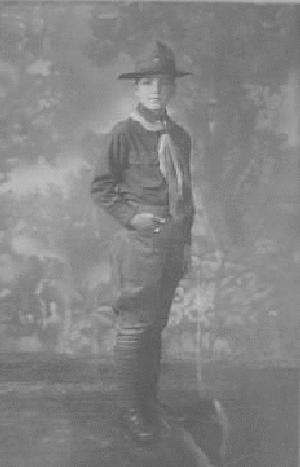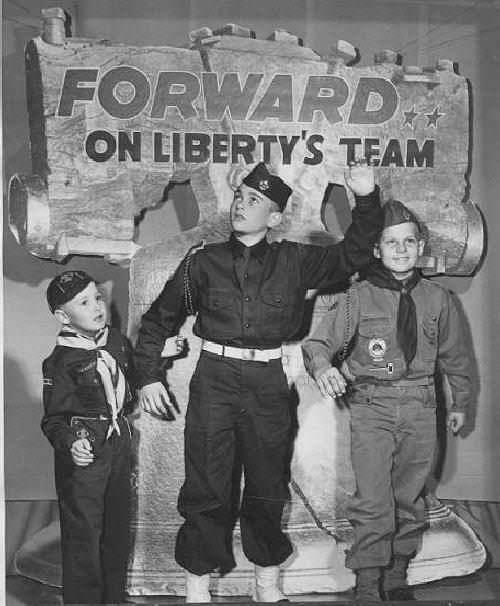
United States Boy Scout Uniforms: Image

Figure 1.--This Scout looks to have been photographed in the 1920s. A smartly uniformed Boy Scout in the minds of some projects a goody-goody image that some American boys reject. While many American Boy Scouts wsore knickers, short pants were more problematical.
|
A factor which has affected Scoting in America, especially among older boys, is the goody-goody image of the movement. This goody-goody image is related to some extent with social-class factors. To many a smartly uniform. well disciplined Scout projects a middle-class image of rectitude and proper rearing while poorly dressed, boys larking about projects the image of the indolent, pporly raised working class. Scouts might be taunted by other boys because of the orgnization's goody-goody image. I remember in the 1950s that in our elementary schools there was a Scouts day once a week in which boys and girls proudly wore their uniforms. There was no taunting, but this was a middle-class neighborhood of Washington, DC. Notably boys did not wear their uniforms to high school. The uniform in part projected this image. This was not a particular problem in the 1920s when most noys wore knickers, but fewer boys were wearing knickers, especially by the late 1930s. Both rich and poor boys had worn knickers in America, but short oants were much more common with boys from affluent than pooer families. This shorts acquired a kind of little rich boy, goody-goody image.
Scouting Image
A factor which has affected Scoting in America, especially among older boys, is the goody-goody image of the movement. This goody-goody image is related to some extent with social-class factors. To many a smartly uniform. well disciplined Scout projects a middle-class image of rectitude and proper rearing while poorly dressed, boys larking about projects the image of the indolent, poorly raised working class. Scouts might be taunted by other boys because of the orgnization's goody-goody image.
BSA Policies
The BSA, especially in the early years of Scouting, did not always taken into account the opinions and feelings of boys. Some of their efforts seems more directed at patents. Early BSA publicity campaigns appears to touched on class distinctions at least implied by the uniform. The BSA would contrast smartly outfitted Scouts to carlessly dressed, indolent boys. In one particularly outrageous example, Memphis newsboys who probably worked harder than BSA executives were outraged to find their photo used as an example of irresponsible lazy boys in a Boy Scout publicity circular Of course the BSA had keyed on the fact that they were not well dressed. The newsboys threatened court action. The local paper reported that BSA officials smudged out the boys' faces and the 'newsies' organized their own Scout troop. [Macleod, p. 223.]
Scout Day
I remember in the 1950s that in our elementary schools there was a Scout Day once a week in which boys and girls, including Cubs and Brownies, proudly wore their uniforms. There was no taunting, but this was a middle-class neighborhood of Washington, DC. Notably boys did not wear their uniforms to high school. Some junior high schools did have Scout Day in which Scouts wore their uniforms.
The Pants
Both rich and poor boys had worn knickers in America, but short pants were much more common with boys from affluent than pooer families. This shorts acquired a kind of little rich boy, goody-goody image. Very young American boys wore shorts, but in most parts of Ameruica, boys generally baegan wearing either knickers or longpants within a few years of beginning elementary school. This was different in affluent neighborhoods or pruvate school. As fewer older boys began wearing shortys in the 1930s, knickers also began to acquire this image, but it was short pants more than anything that affected how some American boys viewed Scouting.

Figure 2.--These Scouts were photographed for BSA publicity about 1951. Even American Cub Scouts mostly refused to wear short pants. This did not begin to change until the 1970s.
|
The Scout Uniform
The uniform in America in part projected this goody-goody image--especially the type of pants worn.
Scouts
This was not a particular problem in the 1920s when most boys wore knickers. Even quite old boys wore kniockers in the 1910s and eraly 20s. Fewer boys were wearing knickers, especially older boys, by the late 1930s. This was part of the reason that short pants were not commonly worn by American Scouts, even after the BSA Nation Headquarters began promoting shorts in the 1920s. Short pants apparently "... so mortified the poorer boys that Scoutmaster A.H. Durieux of Paterson, New Jersey, reported they flatly refused to go bare-kneed." [Macleod, pp. 222-223.]
Cubs
Interestingly even Cubs refused to wear short pants in America. While there are many images of Cubs wearing knickers in the 1930s, there are few inages of Cubs from the 1930s (when Cubbing began in America) even to the 1960s wearing short pants. There was a short pants uniform and some Cubs wore it, espcially in the South, but the great majority of American Cubs wore either knickers or long pants. his only began to change in the 1970s.
Sources
Macleod, David I. Building Character in the American Boy: The Boy
Scouts, YMCA, and Their Forerunners, 1870-1920 (The University of Wisconsin Press,
1983), 315p.
Christopher Wagner

Navigate the Historic Boys' Uniform Chronology Pages:
[Return to the Main chronologies page]
[The 1900s]
[The 1910s]
[The 1920s]
[The 1930s]
[The 1940s]
[The 1950s]
[The 1960s]
[The 1970s]
[The 1980s]
[The 1990s]
[The 2000s]
Navigate the Historic Boys' Uniform Web Site:
[Activities]
[Biographies]
[Chronologies]
[Countries]
[Essays]
[Garments]
[Organizations]
[Religion]
[Other]
[Introduction]
[Bibliographies]
[Contributions]
[FAQs]
[Questions]
[Unknown images]
[Boys' Uniform Home]
Navigate the Historic Boys' Uniform Web organization pages:
[Return to the Main U.S. Scouting page]
[Return to the National Scout page]
[Boys' Brigade]
[Camp Fire]
[Hitler Youth]
[National]
[Pioneers]
[Royal Rangers]
[Scout]
Created: July 24, 2002
Last updated: July 24, 2002




